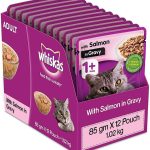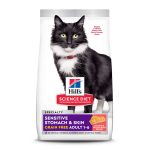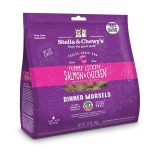Whisk Up A Lip-Smacking Gravy For Cat Food Recipe: Irresistible Delight For Your Feline Friend!
Gravy for Cat Food Recipe: A Delicious and Nutritious Addition to Your Feline’s Diet
Greetings, Cats Lovers! If you’re looking to enhance your furry friend’s mealtime experience, why not consider adding a homemade gravy to their cat food? Not only does it make their meal more palatable, but it also provides additional nutrition that can benefit their overall health and well-being. In this article, we will explore the ins and outs of making a delectable gravy for cat food, ensuring that your feline companion gets the best dining experience possible.
Table: Gravy for Cat Food Recipe
Ingredients
Instructions
Benefits
1 cup chicken broth
1. Heat the chicken broth in a saucepan.
Provides hydration and added flavor.
1 Picture Gallery: Whisk Up A Lip-Smacking Gravy For Cat Food Recipe: Irresistible Delight For Your Feline Friend!

1 tablespoon cornstarch
2. In a separate bowl, mix the cornstarch with a small amount of water to create a slurry.
Thickens the gravy for a satisfying texture.

Image Source: goingevergreen.org
1/4 cup water
3. Slowly pour the cornstarch slurry into the heated broth, stirring constantly.
Helps bind the ingredients together.
1/4 teaspoon dried catnip (optional)
4. Add the dried catnip for an extra flavor boost.
Offers a delightful aroma that cats love.
1 tablespoon fish oil (optional)
5. Drizzle the fish oil into the mixture, providing essential fatty acids for a healthy coat.
Improves skin and coat health.
Salt and pepper to taste
6. Season with salt and pepper to enhance the flavor.
Enhances taste without compromising health.
1/2 teaspoon dried parsley (optional)
7. Sprinkle the dried parsley to add a touch of freshness.
Contains antioxidants and essential nutrients.
What is Gravy for Cat Food Recipe?
Gravy for cat food recipe refers to a homemade sauce that can be added to your feline friend’s regular meals. It is typically made from ingredients such as chicken broth, cornstarch, and optional additives like dried catnip or fish oil. This delicious addition not only enhances the flavor of your cat’s food but also provides additional nutrients that can benefit their overall health.
Who Can Benefit from Gravy for Cat Food Recipe?
Cats of all ages and breeds can benefit from the inclusion of gravy in their diet. Whether you have a picky eater who needs some enticement or a senior cat who requires more moisture in their meals, this recipe can cater to their specific dietary needs. Additionally, cats with dental issues or those recovering from illness may find it easier to consume their food with the help of a tasty gravy.
When Should You Serve Gravy for Cat Food Recipe?
You can serve the gravy for cat food recipe at every mealtime or as an occasional treat for your feline companion. It can be poured over dry or wet food, providing a burst of flavor and moisture. Additionally, it can be used to entice finicky eaters or to add variety to their usual diet. Experiment with different flavors and combinations to find what your cat enjoys the most.
Where Can You Find the Ingredients for Gravy for Cat Food Recipe?
The ingredients for gravy for cat food recipe can be found in most grocery stores or pet supply shops. Chicken broth, cornstarch, and dried herbs are readily available. For optional ingredients like dried catnip or fish oil, you can find them in pet specialty stores or online. Ensure that all ingredients are cat-friendly and suitable for their dietary needs before using them in the recipe.
Why Should You Consider Making Gravy for Cat Food Recipe?
Making gravy for your cat’s food offers several benefits. Firstly, it can entice picky eaters to consume their meals, ensuring they receive the necessary nutrients. The added moisture from the gravy can also aid in digestion and prevent dehydration, especially for cats who do not drink enough water. Furthermore, the recipe allows you to have control over the ingredients, ensuring that your cat receives a wholesome and nutritious meal.
How to Make Gravy for Cat Food Recipe?
Making gravy for cat food recipe is a simple process that can be done in just a few minutes. Follow these steps:
Heat the chicken broth in a saucepan.
In a separate bowl, mix the cornstarch with a small amount of water to create a slurry.
Slowly pour the cornstarch slurry into the heated broth, stirring constantly.
Add the optional dried catnip for an extra flavor boost.
Drizzle in the fish oil, if desired, for additional health benefits.
Season with salt and pepper to taste.
Sprinkle dried parsley over the mixture for added freshness.
Once the gravy has thickened, it is ready to be poured over your cat’s food. Allow it to cool slightly before serving to prevent any burns. Store any leftover gravy in an airtight container in the refrigerator for up to three days.
Advantages and Disadvantages of Gravy for Cat Food Recipe
Advantages
1. Enhanced Taste and Aroma: The addition of gravy to cat food can make it more appealing to finicky eaters, ensuring they get the nutrients they need.
2. Added Moisture: Gravy increases the moisture content of your cat’s food, promoting digestion and preventing dehydration.
3. Control over Ingredients: Making your own gravy allows you to choose high-quality ingredients and avoid additives or fillers that may be present in commercial products.
4. Nutritional Benefits: By adding optional ingredients like dried catnip or fish oil, you can provide additional nutrients that support your cat’s health.
5. Variety in Diet: Gravy adds variety to your cat’s meals, preventing boredom and encouraging a healthy appetite.
Disadvantages
1. Time and Effort: Making homemade gravy requires some time and effort compared to the convenience of commercial options.
2. Potential Allergies or Sensitivities: Some cats may have allergies or sensitivities to certain ingredients, so it is essential to monitor their reactions when introducing new flavors.
3. Overconsumption: Cats may become reliant on the gravy and refuse to eat their food without it, potentially leading to an unbalanced diet.
4. Storage and Shelf Life: Homemade gravy needs to be stored properly and used within a few days to prevent spoilage or contamination.
5. Individual Preferences: Not all cats may enjoy the taste or texture of gravy, so it may take some trial and error to find a recipe that suits your cat’s palate.
Frequently Asked Questions (FAQs)
Q1: Can I use vegetable broth instead of chicken broth?
A1: Yes, vegetable broth can be used as an alternative for chicken broth if your cat has dietary restrictions or preferences. Ensure that the vegetable broth is free from onions or other toxic ingredients.
Q2: Is it safe to add fish oil to the gravy?
A2: Fish oil can provide beneficial omega-3 fatty acids for your cat’s health. However, consult with your veterinarian before adding any supplements to your cat’s diet to ensure it is appropriate for their individual needs.
Q3: My cat is diabetic. Can they have gravy?
A3: If your cat has diabetes or any other medical condition, it is crucial to consult with your veterinarian before making any dietary changes. They can provide guidance on suitable options for your cat’s specific needs.
Q4: How often should I serve gravy to my cat?
A4: The frequency of serving gravy can vary depending on your cat’s preferences and dietary requirements. It is generally safe to serve it with every meal or a few times a week as a treat.
Q5: Can I freeze homemade gravy?
A5: Yes, you can freeze homemade gravy in ice cube trays or small containers for convenient portioning. Thaw it in the refrigerator before serving.
Conclusion
By adding a homemade gravy to your cat’s food, you can elevate their mealtime experience while providing them with essential nutrients. The gravy enhances the taste, aroma, and moisture content of their food, ensuring that they receive a balanced and enjoyable meal. Remember to consider your cat’s individual preferences, dietary needs, and consult with your veterinarian if necessary. So why wait? Treat your feline companion to a delicious and nutritious gravy for cat food recipe today!
Disclaimer: The information in this article is for educational purposes only and is not intended to replace professional advice. Consult with your veterinarian before making any changes to your cat’s diet.
This post topic: Cats



